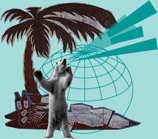Act 2: Greenland, April 21 – May 14, 2006
ART EXHIBITION
Contested Territories: Representing
Postcolonial Interests
Greenland National Museum and Archives, Nuuk
April 21 – May 14, 2006
Opening Friday, April 21, 2006, 5 – 8 pm
Press Preview Friday, April 21, 2006, 2 – 4 pm
This exhibition focuses on contemporary experiences with postcolonial
societies and cultures. Identities are examined in their relationship to such
factors as state, militarization, and globalization, but also in relationship to
landscape and memory. It addresses questions of dependency and
marginalization, and proposes ways out of subordination.
The exhibition is accompanied by the film program Silver Screen Resistance
(for screening hours and participant information, click here).
PARTICIPATING ARTISTS / ORGANIZATIONS
Center for Land Use Interpretation (USA)
Katrine Dirckinck-Holmfeld in collaboration with Inuit Youth International (IYI) (Denmark & Greenland)
Tamar Guimarães (Brazil/Denmark)
Marja Helander (Sámi, Finland)
Moshekwa Langa (South Africa/The Netherlands)
FILM PROGRAM PARTICIPANTS
Stephanie Black (USA)
Randi Broberg in collaboration with Tine Bryld (Greenland/Denmark & Denmark)
Laila Hansen (Greenland)
Isaac Julien (United Kingdom)
Alanis Obomsawin (Abenaki, Canada)
Pratibha Parmar (Kenya/United Kingdom)
Gillo Pontecorvo (Italy)
Paul-Anders Simma (Sámi, Norway/Sweden/Finland)
Address/Hours/Admission:
Hans Egedevej 8, 3900 Nuuk
t: +299 32 26 11, e: nka@natmus.gl
www.natmus.gl
Tuesday – Sunday, 1 – 4 pm
Admission free
CENTER FOR LAND USE INTERPRETATION
Founded in 1994. Based in Los Angeles, USA.
Dedicated to the increase and diffusion of information about how the nation’s lands are apportioned, utilized, and perceived.
The Center for Land Use Interpretation is an educational organization that produces public exhibits, displays, interpretive installations, and other programs that explore the relationship between humans and the physical landscape. The Center was established in 1994 and is currently headquartered in Los Angeles, with regional offices and field locations in New York, Wendover, Utah, and the Mojave Desert. The center works with local, national, and international cultural institutions in the production of public programs that deepen the collective understanding of the nature and extent of mankind’s interaction with the earth’s surface.
The Center for Land Use Interpretation contributes with a new project entitled “Arctic as Arena of Space.” CLUI writes about the project: “Heading towards the poles, space/time folds onto itself, and disparate worlds merge into one another. In the Arctic, converging lines of longitude catch nations in a cartographic net, pulling the competing powers of the Northern hemisphere into collision. It is here, then, where the most extreme electronic fortresses and entrenchments were laid between East and West. Engaged in a war of silence, massive sensitive antennas watched for movements, straining to detect in the invisible spectrum. Dark deadly vessels glided silently beneath the ice, hair-triggered to strike with a terminal conflagration. The Arctic was the front line for the cold, Cold War. And history continues. Towards the poles, as habitability decreases, and the surface becomes global, the white expanse of remote Arctic ground appears, in the imagination, like the terrestrial equivalent of the black void that surrounds the earth, until, at the zero points, a purely planetary place, space blends with Space. As hemispheric defenses continue to evolve, and the satellite belt tightens around the globe, the Arctic continues to be the arena of these remotely linked sensors, eyes, and swords. The battle continues to be played out silently, out of sight and mind.” [Center for Land Use Interpretation]
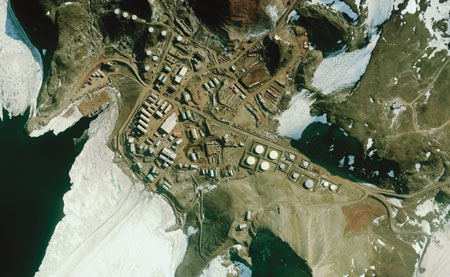
The United States McMurdo Station at Antarctica. Image from the USGS.
Courtesy of the Center for Land Use Interpretation.
KATRINE DIRCKINCK-HOLMFELD in collaboration with INUIT YOUTH INTERNATIONAL (IYI)
Born 1981 in Aalborg, Denmark. Lives and works in Copenhagen, Denmark.
Founded 2001 in Nuuk, Greenland. Based in Nuuk.
Katrine Dirckinck-Holmfeld is a MFA candidate at The Royal Danish Academy of Fine Arts in Copenhagen. Recently, she has been living in Beirut, Lebanon, where she has continued her studies at Acadèmie Libanaise des Beaux Arts (ALBA) and has followed the program of an art teacher in one of the kinder gardens of Ghassan Kanafani’s Cultural Foundation in the Palestinian camps in Lebanon. Katrine considers herself a cultural worker informed by feminist and critical theory. Her artistic investigations take on various directions and forms, from activist strategies to more conventional artistic practices. But in large, her projects have more or less been turning around artistic education and the creation of a plural public sphere. She has co-organized, curated, and published the Women’s 96th Anniversary (2004), a feminist subversion of the 250th Anniversary of The Royal Danish Academy of Fine Arts in Copenhagen. Other than participating in a number of not-worth-mentioning exhibitions in Denmark, Mexico, and Lebanon, she has written articles and reviews and held workshops, latest “Nationalism, Cultural Territories and the Role of Cultural Producers” at the Next Stop Summer University in Vukovar, Croatia, 2005.
Inuit Youth International (IYI) is a grass roots organization, which was founded during a general assembly in Nuuk in 2001. From the very beginning, the goal of IYI has been to work for and involve youth in a progressive national and local collaboration in a time of great turbulence. IYI has organized several events on the questions of Inuit identity, spirituality, and how to overcome the barriers of cultural taboos such as suicide, homosexuality, and so forth.
Katrine Dirckinck-Holmfeld and Inuit Youth International contribute with “Youth Writes Back,” an e-learning lab consisting of a workshop and a multimedia installation. They write about the project: “‘Youth Writes Back’ aims to examine postcolonial situations from a youth and educational perspective. The project wishes to bring young activists, artists, and educators from different postcolonial situations together in order to discuss, intervene, and invent new methods of exploring how education has been used to reproduce the colonial hegemony, and how we through education as a creative process can reveal a deeper understanding of our different cultural values, environments, and perspectives on ‘glocal’ issues. In Scandinavia, and specifically in Denmark, there exists a very limited education on the colonial past and present of those countries. This could be referred to as powerful ignorance. The Danes somehow still perceive of themselves not as colonizers but as ‘aid-administrators,’ who came to the rescue of our ‘poor neighbors.’ This perception of the people of Greenland as not being able to help themselves does not reflect reality, but serves to smooth over the conscience of the colonizers. To produce other images and stories opposed to the ruling, we will go out into the city of Nuuk and its surroundings and investigate themes of ‘My City,’ ‘Language,’ and ‘Dig-I-dentity.’ All the material accumulated during the workshop will be presented in the exhibition and hopefully on the UNESCO web portal for Young Digital Artists: portal.unesco.org/culture/en. [Katrine Dirckinck-Holmfeld and Inuit Youth International]
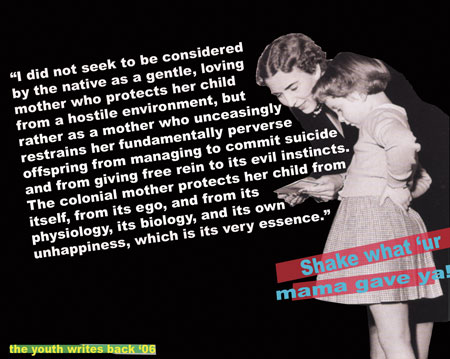
Katrine Dirckinck-Holmfeld, “Colonial Mother, Notes for ‘Youth Writes Back,’” 2006.
Photo of Queen Ingrid and Princess Anne-Marie from the book I den bedste mening by Tine Bryld, 1998.
Quote Frantz Fanon, The Wretched of the Earth, 1963. Courtesy of the artist.
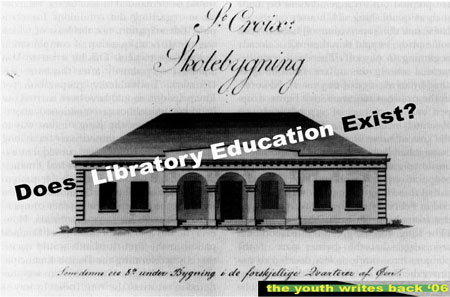
Katrine Dirckinck-Holmfeld, “Does Libratory Education Exist? Notes for ‘Youth Writes Back,’” 2006.
Illustration of one of the school buildings for children of slaves in St. Croix, The West Indies.
Courtesy of the artist.
TAMAR GUIMARÃES
Born in Brazil. Lives and works in Copenhagen, Denmark.
Tamar Guimarães graduated from Goldsmiths College, London in 2002, was a guest at The Royal Danish Academy of Fine Arts in Copenhagen from 2002-04, and is currently a master student at the Malmö Art Academy in Sweden. She views her practice as a way of reflecting on the power relations underpinning social interactions and of considering the relationship between history and subjectivity in a postcolonial environment.
Tamar Guimarães participates with “Jan Leton and the archive” (2006), a slide projection examining the story of Jan Leton and the history of the Danish Triangular Trade. Guimarães writes about the project: “Jan Leton was a man born in the West Indies. In the early 19th century, he was given as a gift to the bailiff of Skagen and lived there, as the bailiff’s servant, until his death in 1827. Leton’s death record is the only official document in which his presence in Skagen is marked in writing during his ‘lifetime.’ He does, however, appear periodically in the papers and local history narratives from 1877 onwards. My investigation on Leton has been translated into a narrative, in which a researcher attempts to find out more about a man, who had arrived as a slave but was later freed, had been buried in the forest but later dug up and reburied in the church grounds.
Some of the narratives that the researcher encounters in archived newspapers and local theater plays suggest that an earlier wrong had been repaired. Others, that there was a collective amnesia about the Danish involvement in the transatlantic slave trade. Part of the stories describe how Leton, at the bailiff’s services, planted the first forest which was successful in stabilizing the drifting sands; an ongoing concern in an area where large dunes move fifteen centimeters every year. This forest is now known as The Bailiff’s Forest.
As the researcher attempts to follow the variations on the narratives on Jan Leton, she enters the terrain of contestation of the various ways in which Jan Leton’s presence in Skagen have been inscribed. Another part of the project entails an entry on the Danish Wikipedia on Jan Leton and the Danish slave trade, written in collaboration with Christian Hillesø and others.” [Tamar Guimarães]
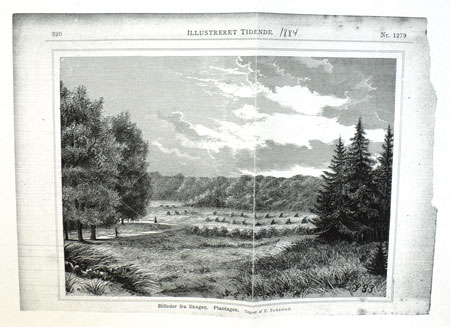
Tamar Guimarães, Research material for “Jan Leton, the monkey, the archive,” 2006.
Photocopy of an engraving of the forest in Skagen from an 1884 newspaper.
The forest was known as Plantagen (The Plantation). Courtesy of the artist.
MARJA HELANDER
Born 1965 in Helsinki, Finland. Lives and works in Helsinki.
Originally, I graduated as a painter from the Lahti Institute of Fine Arts in 1992. However, I used mostly photographs in my works, so I decided to deepen my knowledge on photography. That’s why I chose to study photography. I graduated from the University of Art and Design in Helsinki in 1999. My career as an artist photographer started 12 years ago. In 1994, I was one of the ten finalists of the Foto Finlandia competition. Since then, I have presented my works in solo and group exhibitions both in Finland and abroad. In recent years, my works have been shown a lot in Scandinavia, for example in the Hasselblad Center in Gothenburg, BildMuseet in Umeå, Charlottenborg Exhibition Hall in Copenhagen, and Galleri F15 in Moss, Norway.
My photographs are based on my Sámi background. Sámi people are the indigenous people of Scandinavia. Traditionally, they have lived by reindeer breeding, hunting, and fishing in the northern parts of Finland, Sweden, Norway, and Russia. In my photos, I have studied the conflict between the traditional Sámi way of living and modern society. My works also consider my own identity between two cultures – the Finnish and the Sámi culture. My father is a Sámi, but I was brought up in the south of Finland, far away from the Sámi land, tradition, and language. The conflict between past and contemporary life interests me. My photos tell about a modern person, who is totally lost in her traditional Lappish environment. She doesn’t understand her position. She walks on the mountains following the footsteps of her ancestors, reindeer breeders. The movement continues, but the frame of reference is different. Some of the pictures have been taken in Fiord Varang in Norway. That’s the place where the first inhabitants of Northern Scandinavia, the Sámi people, arrived some 10,000 years ago. They were nomads, who wandered over the country, looking for game. Where the Sámi huts stood before, oil tanks of multinational oil companies rise today. The deep connection between man and nature belonged to the traditional Sámi way of life. The Sámi didn’t look at the landscape, rather they were in the landscape, a part of it. At present, this connection has been broken or weakened at least. In modern life, people need different means than in ancient societies and in the woods and the deserts. New species have been born; species of modern nomads who wander from one country to another, looking for meaning, without any ties anywhere. [Marja Helander]
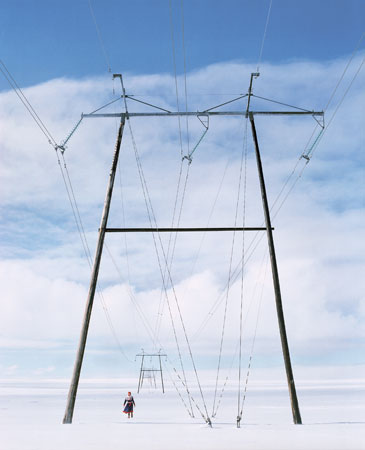
Marja Helander, “Mount Annivaara, Utsjoki,” 2002.
Chr. C-print, 117 x 93 cm. Courtesy of the artist.
MOSHEKWA LANGA
Born 1975 in Bakenberg, South Africa. Lives and works in Amsterdam, The Netherlands.
Moshekwa Langa is a visual artist working with drawings, installations, videos, paintings, and photography. He was born in South Africa and attended different government schools in the then Lebowa area, part of a series of homelands created for different ethnic groups with an education system tailored to fit people from those places. In 1989, Moshekwa enrolled in the former Max Stibbe Waldorf School (now called Ubuntu Centre) in the greater Pretoria region. The Waldorf School was based on the philosophies of Rudolf Steiner and the anthroposophical societies. Upon completing his high school studies, he spent two years in a period of introspection and experimentation. He made drawings and sculptural works and wrote texts pertaining to his life and situation in the dawning new country. He also worked as a contributing producer on an arts and culture program called The Works for the South African broadcasting corporation. From 1997-98, Langa then attended the Rijksakademie van beeldende kunsten in Amsterdam. He has participated in numerous public discussions and forums, television and radio specials, and his work has been presented in monographic and group exhibitions such as: The Johannesburg Biennale (1997), The Sao Paulo Biennale (1998), The Short Century: History and Liberation Movements in Africa 1945-1994 (Villa Stuck, 2001), Generation Z (P.S.1 Contemporary Art Center, 2002), Ars 01 (Kiasma, 2002), The 50th Venice Biennale (2003), Looking Both Ways (Museum for African Art, New York, 2003). His solo shows include: Live and in Person (The Renaissance Society, Chicago, 1998), Another Time, Another Place (The Goodman Gallery, Johannesburg, 2001), Present + Tense (Düsseldorf Kunstverein, 2004), Moshekwa Langa (Maxxi Museum, Rome, 2005), and The man who cast no shadows (Tache-Levy Gallery, Brussels, 2006).
Moshekwa Langa participates with the video work “Where do I begin” from 2001 and a new piece. “Where do I begin” is a work on two screens: one shows the lower parts of people’s bodies getting on a bus, the other displays the movement of very blue water flowing in a river. One sees details of clothing and shoes of the people getting on the bus. There are no dialogues. The soundtrack consists of ambient noises and parts of the song “Where do I begin” performed by Shirley Bassey, which has given the work its title. The new piece consists of two drawings made with Indian ink and acrylic on paper. The drawings are made up of texts, names of people and places, and collage elements. The piece is an associative map of memories as well as private and public terms. The maps are colorful, subjective, and indecipherable. [Moshekwa Langa]
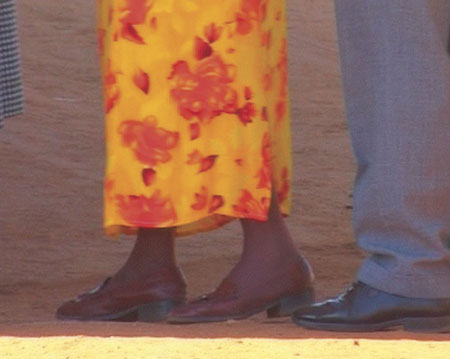
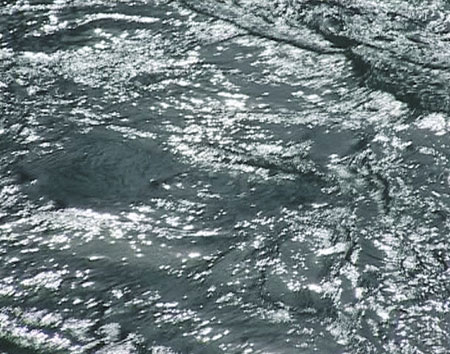
Moshekwa Langa, Video stills from “Where do I begin,” 2001.
Two channel video work, 4.5 min. Courtesy of the artist.
Act 2: Greenland, April 21 – May 14, 2006
PUBLIC HEARING
Debating Independence: Autonomy or
Voluntary Colonialism?
The Teachers’ Training School of Greenland, Nuuk
April 22 – 23, 2006, both days 12 – 5 pm
This two-day public hearing debates self-government and various models of autonomy and accountability. It will seek to complicate our understanding of dependence and independence according to such dividers as class, race, gender, and sexuality. Audiences are encouraged to participate and share their own experiences with the speakers. [Simultaneous interpretation will be available]
PARTICIPANTS
M. Jacqui Alexander (Canada)
Katrine Dirckinck-Holmfeld in collaboration with
Humphrey Polepole and Ivaaq Poulsen (Denmark, Tanzania & Greenland)
Paul Gilroy (United Kingdom)
Høgni Hoydal (The Faroe Islands)
Aviâja Egede Lynge (Greenland)
MODERATOR: Daniel Thorleifsen (Greenland)
Address/Admission:
C. E. Janssensvej 2, 3900 Nuuk
t: +299 32 11 91, e: ilinnia@greennet.gl
www.ilinniarfissuaq.gl
Admission free
Public Hearing Program (download program here):
Day 1: April 22
12 –12:30 pm: Introduction to the public hearing by Kuratorisk Aktion (Curators of Rethinking Nordic Colonialism) and Daniel Thorleifsen (Director, Greenland National Museum and Archives, Nuuk).
12:30 – 1:30 pm: “Colonial crimes and convivial cultures,” a presentation by Paul Gilroy (Anthony Giddens Professor of Social Theory, Department of Sociology, London School of Economics, United Kingdom). The presentation is followed by & Questions & Answers session.
1:30 – 2 pm: Coffee & Snack Break.
2 – 3 pm: “Colonial Influence on Ethnic Identity and Self-determination in Greenland – Seen from the Perspective of Ethnicity and Nationalism,” a presentation by Aviâja Egede Lynge (MA in Social Science and Social Anthropology from the University of Edinburgh, Scotland). The presentation is followed by a Questions & Answers session.
3 – 3:15 pm: Coffee Break.
3:15 – 4:15 pm: “Colonialism and its Contemporaries: Feminist Reflections on the State of War and the Meaning of Solidarity,” a presentation by M. Jacqui Alexander (Professor at the Institute for Women’s Studies and Gender Studies, University of Toronto, Canada). The presentation is followed by a Questions & Answers session.
4:15 – 5 pm: Open Discussion and Closing Remarks.
Day 2: April 23
12 – 12:30 pm: Opening Remarks by Daniel Thorleifsen (Director, Greenland National Museum and Archives, Nuuk).
12:30 – 1:30 pm: “Neo-colonialism with a human face – the cosy self-colonization in Danish home rule,” a presentation by Høgni Hoydal (Chairman of the Faroese left-wing independence party Tjóðveldisflokkurin (The Republicans) and member of the Faroese and Danish Parliaments). The presentation is followed by a Questions & Answers session.
1:30 – 2:15 pm: Coffee & Snack Break.
2:15 – 3:15 pm: “Youth Writes Back: Performative notes from a workshop on youth experiences and postcolonial situations,” a presentation by Katrine Dirckinck-Holmfeld (Visual artist and MFA Candidate at The Royal Danish Academy of Fine Arts, Copenhagen, Denmark) in collaboration with Humphrey Polepole (Secretariat Director of the Tanzania Youth Coalition (TYC) and Steering Committee Member of the Sustainability Watch Network) and Ivaaq Poulsen (Professional diver and member of Inuit Youth International (IYI), Nuuk, Greenland). The presentation is followed by a Questions & Answers session.
3:15 – 3:30 pm: Coffee Break. 3:30 – 5 pm: Open Discussion and Closing Remarks.
M. JACQUI ALEXANDER
Currently lives and works in Toronto, Canada.
M. Jacqui Alexander is a teacher, writer, and scholar, currently at the Institute for Women’s Studies and Gender Studies at the University of Toronto. She has written extensively on the heteronormative, regulatory practices of the modern state and the different ways in which radical communities, both outside and inside the academy, position themselves in relation to these practices. Her most recent scholarship has taken up questions of the sacred dimensions of experience and the meaning of sacred subjectivity. It also involves writing the life of an enslaved Kongolese woman in the Caribbean. Her publications include: Feminist Genealogies, Colonial Legacies, Democratic Futures (Routledge, 1997) with Chandra Talpade Mohanty; Sing, Whisper, Shout, Pray! Feminist Visions for a Just World (Edgework, 2002) with Sharon Day, Lisa Albrecht, and Mab Segrest; Pedagogies of Crossing: Meditations on Feminism, Sexual Politics, Memory and the Sacred (Duke, 2006). She is a member of the Caribbean Association for Feminist Research and Action.
M. Jacqui Alexander will present the paper “Colonialism and its Contemporaries: Feminist Reflections on the State of War and the Meaning of Solidarity.” The paper marks the continuities and discontinuities between this contemporary moment of empire building and earlier forms of colonization in order to establish how the colonial is implicated in the modern. She uses a transnational feminist framework to show that these processes are simultaneously racialized, sexualized, and gendered. State here is meant to refer to the militarized imperatives at work in the neo-imperial state, the states of violence that promote silence and patriotism, and the psychic states that rely on segregations and the production of the “enemy” as grounds on which to constitute citizenship. She ends by reflecting upon the need to build interdisciplinary political solidarity networks that cross boundaries of various kinds. [M. Jaqui Alexander]
KATRINE DIRCKINCK-HOLMFELD in collaboration with HUMPHREY POLEPOLE and IVAAQ POULSEN
Born 1981 in Aalborg, Denmark. Lives and works in Copenhagen, Denmark.
Lives and works in Dar es Salaam, Tanzania.
Lives and works in Nuuk, Greenland.
Katrine Dirckinck-Holmfeld is a MFA candidate at The Royal Danish Academy of Fine Arts in Copenhagen. Recently, she has been living in Beirut, Lebanon, where she has continued her studies at Acadèmie Libanaise des Beaux Arts (ALBA) and has followed the program of an art teacher in one of the kinder gardens of Ghassan Kanafani’s Cultural Foundation in the Palestinian camps in Lebanon. Katrine considers herself a cultural worker informed by feminist and critical theory. In large, her projects turn around artistic education and the creation of a plural public sphere. She has co-organized, curated, and published the Women’s 96th Anniversary (2004), a feminist subversion of the 250th Anniversary of The Royal Danish Academy of Fine Arts in Copenhagen. She has written articles and reviews and held workshops, latest “Nationalism, Cultural Territories and the role of Cultural Producers” at the Next Stop Summer University in Vukovar, Croatia, 2005.
Humphrey Polepole is the current Secretariat Director of the Tanzania Youth Coalition (TYC), the biggest youth movement in Tanzania. He is also the Steering Committee Member of the Sustainability Watch Network under Tanzania Coalition on Sustainable Development (TCSD). He has recently been elected to join the Steering Committee of the Social Watch preparation at the East African sub-region and is a member of Policy Advisory Board of MS Tanzania. Polepole has held several positions at local, national, and international levels in the civil society and in the United Nations as a United Nations Environment Programme Associate Youth Advisor for Africa. He has also taken an active role in the Rio+10 NGO process in the South and is a Chair of the East African Youth Coalition (EAYC) on Sustainable Development. He was selected to join a six people taskforce to anticipate the future of the sustainable development NGO process in East Africa.
Ivaaq Poulsen is a professional diver and active member of Inuit Youth International (IYI). IYI is a grass roots organization, which was founded during a general assembly in Nuuk in 2001. From the very beginning, the goal of IYI has been to work for and involve youth in a progressive national and local collaboration in a time of great turbulence. IYI has organized several events on the questions of Inuit identity, spirituality, and how to overcome the barriers of cultural taboos such as suicide, homosexuality, and so forth.
Katrine Dirckinck-Holmfeld, Humphrey Polepole, and Ivaaq Poulsen will talk about their collaborative project for Rethinking Nordic Colonialism’s Act 2 exhibition, “Youth Writes Back,” an e-learning lab consisting of a workshop and a multimedia installation. Their presentation is titled “Youth Writes Back: Performative notes from a workshop on youth experiences and postcolonial situations” and they describe it as follows: “A school… on the black board is written: ‘A girl walks toward her mother with a bucket.’ The bucket starts bursting…its content is floating over the edge…What happens when the youth writes back? Equipped with digital cameras, cellular phones, and audio recording equipment, we will go out into the city of Nuuk and its surroundings to investigate themes of ‘My City,’ ‘Language,’ and ‘Dig-I-dentity.’ In the public hearing, ‘Youth Writes Back’ will create a platform for presenting experiences gathered during the workshop «Circumpolar Young Digi-Artists», to raise discussion on education as a creative process, in which deeper understandings of our different cultural values, environments, and perspectives on ‘glocal’ issues will become visible.” [Katrine Dirckinck-Holmfeld, Humphrey Polepole, and Ivaaq Poulsen]
PAUL GILROY
Born 1956 in London, United Kingdom. Lives and works in London.
Paul Gilroy teaches at the London School of Economics. Before that, he was a Charlotte Marian Saden Professor of Sociology and African American Studies at Yale University, where he was Chair of the African American Studies Department. He is the author of several books and his work has been translated into eleven languages.
Paul Gilroy’s presentation “Colonial crimes and convivial cultures” will discuss the relationship between the history and remembrance of colonial rule, and the constitution of multicultural societies in the postcolonial phase. He will address the arguments towards the revival of empire that have been such a notable feature of the “war on terror” as well as the predicament of various ethnic minorities in the overdeveloped countries. [Paul Gilroy]
HØGNI HOYDAL
Born 1966 in Copenhagen, Denmark. Lives and works in Hoyvík, The Faroe Islands.
Høgni Hoydal is the Chairman of Tjóðveldisflokkurin in the Faroe Islands. Tjóðvelisflokkurin is a left-wing independence party and is currently the biggest political party in the Faroe Islands. Aside from being a member of the Faroese Parliament, Hoydal has been elected to the Danish Parliament for Tjóðveldisflokkurin since November 2001. From 1998-2003, he held the post of Deputy Prime Minister and Minister for Self-Government, Judicial & Nordic Affairs in the Faroe Islands. Hoydal lives together with Hildur Hermansen and they have three children. He has a degree in History and Communication from Roskilde University, Denmark. Before becoming a politician, he was employed as a seaman, temporary teacher, and as a reporter for the Faroese television. Hoydal has written two books concerning political affairs. Myten om Rigsfællesskabet (The Myth of the Union) was published in the spring of 2000 and the second, Frælsi er ábyrgd (Freedom Is Responsibility), was published in December that same year.
Høgni Hoydal participates with the presentation “Neo-colonialism with a human face – the cosy self-colonization in Danish home rule.” In his outline of the presentation, he writes: “Denmark has been able to maintain the sovereignty over two of its colonies right into the age of globalization. This has been possible by allowing room for certain cultural decisions in the home ruling countries Greenland and the Faroe Islands, while the political, economical, and social structures between Denmark and the colonies have led to an effective self-colonization. The self-colonization is based on the myth of Denmark as the assisting and kind mother, who protects her children against the dangerous world outside and who supports them economically without having any self-interest in the relationship. What does this mean to the Faroese and Greenlandic societies and their development and possibilities in the age of globalization? Is it possible to change the Danish self-understanding, which continues to block for the alteration of the relationship? Is the cosy self-colonization becoming the model for neo-colonization of the 21st century? Taking its starting point in Faroese experiences, the presentation will address these questions and propose ways out of neo-colonialism.” [Høgni Hoydal]
AVIÂJA EGEDE LYNGE
Born 1974 in Haslev, Denmark. Lives and works in Nuuk, Greenland.
Aviâja Egede Lynge received her MA in Social Science in Social Anthropology from Edinburgh University, Scotland in 2002 and her BA degree in Tourism Management from Queen Margaret University College, Edinburgh in 2000. During her studies, her fields of interests were postcolonialism, culture, development of indigenous societies, and rural areas. Since 2003, Aviâja has been working for the Greenland Home Rule Government as a Secretary to the Minister of Industry, Agriculture & Labour. Prior to this, she worked in a privately owned Greenlandic company, working with research, courses, integration of Danish and Greenlandic children in the public schools, and development of a Greenlandic empowerment concept. From 1998-2003, she was a board member of different institutions/organizations: Greenland Tourism – The National Tourism Board of Greenland, Inuit Youth International (a grass roots organization, which works to strengthen the cultural and spiritual development through promoting higher self-worth among Inuit youth), SAMIK (a co-operation between Greenland and Iceland for the development of tourism and cultural ties), and Katuaq – Greenland Cultural Centre. She has traveled most of the world, and her greatest interests are better cross-cultural understanding between peoples, politics, postcolonialism, and indigenous peoples’ affairs. She has attended the UN Permanent Forum twice, is an active debater in the Greenlandic and Danish press, and has been speaking in various forums. Currently, she is working on a Greenlandic debate book about the influence of colonialism on Greenlandic identity and self-determination. She hopes that the book will contribute to the written history of Greenland and that it will motivate young Greenlanders to study where they came from to better understand who they are today.
Aviâja Egede Lynge participates with a presentation titled “Colonial Influence on Ethnic Identity and Self-determination in Greenland – Seen from the Perspective of Ethnicity and Nationalism.” In her outline of the presentation, she writes: “There is a need to look beyond our colonial history. In Greenland, we have always been ‘taught’ that ‘Greenland is one of the best colonies in the world.’ However, this should not prevent us from acknowledging how 250 years of colonization has influenced us as a people and how it still affects on our daily lives. When people in Greenland discuss problems such as equality between Danes and Greenlanders, the words ‘racists’ and ‘nationalists’ are often used. Instead of trying to understand how concepts like ‘equality’ and ‘nationalism’ relate to the past, it seems as if the debate never goes further. Therefore, my presentation will take the participant through Greenland’s colonial history (political and cultural) and discuss the colonial influence on Greenlandic identity, continuing feelings of subordination, and a continued search for the acceptance of ethnic identity. The presentation will focus on the question of how ethnic identity plays a role in the picture of ‘equality between Greenlanders and Danes’ with regards to the colonial period and today. The presentation proposes that the colonial influence on Greenlandic identity still has implications today, and that the symptoms of nationalism are leftovers from a lack of mental de-colonization.” [Aviâja Egede Lynge]
